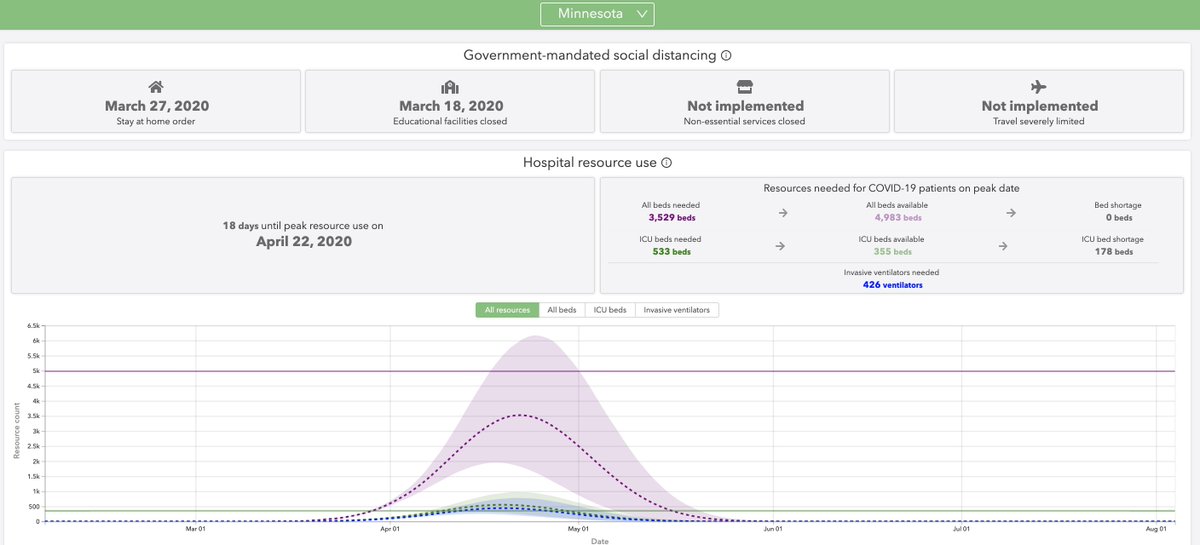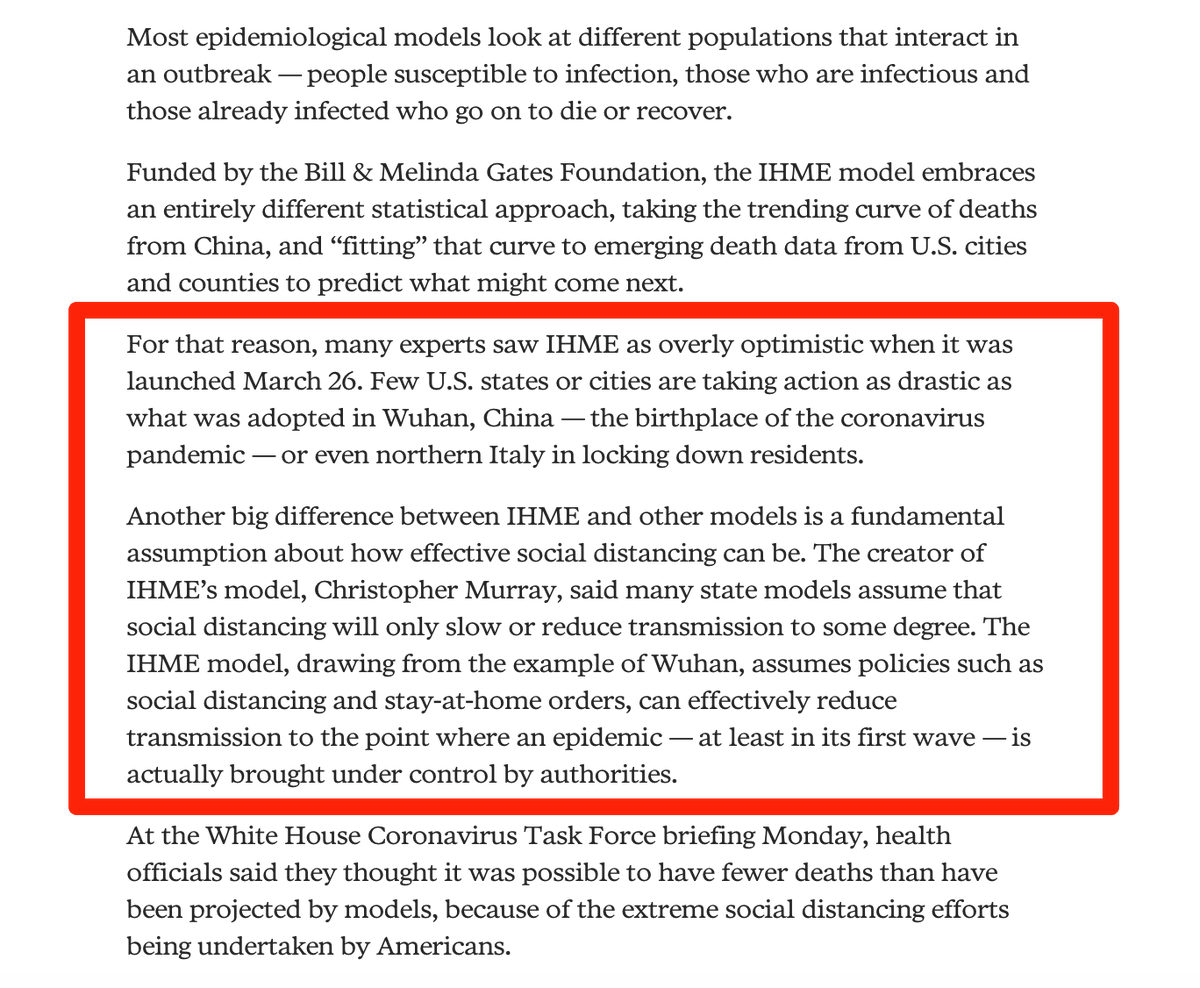When will COVID-19 peak? A state-by-state analysis (according to one model)
“Peek demand for hospital resources due to COVID-19 is expected by mid-April in the U.S., according to an analysis from the University of Washington’s Institute for Health Metrics and Evaluation in Seattle.” - Becker’s Hospital Review
Take a look at the paper PDF linked in the article (and above). I can’t pretend to understand the math, but this is clearly not the work of slouches…. or political hacks.
Views expressed are always my own and not my employer's, my church's, my family's, my neighbors', or my pets'. The house plants have authorized me to speak for them, however, and they always agree with me.
This is actually the key model that is being used right now by everyone.
http://www.healthdata.org/covid/faqs
- The model includes the effects of social distancing measures implemented at the “first administrative level” (in the US this generally means the state level) and assumes continued social distancing through the end of the modeled period (August 4, 2020).
- Our model suggests that, with social distancing, the end of the first wave of the epidemic could occur by early June. The question of whether there will be a second wave of the epidemic will depend on what we do to avoid reintroducing COVID-19 into the population. By the end of the first wave of the epidemic, an estimated 97% of the population of the United States will still be susceptible to the disease and thus measures to avoid a second wave of the pandemic prior to vaccine availability will be necessary. Maintaining some of the social distancing measures could be supplemented or replaced by nation-wide efforts such as mass screening, contact tracing, and selective quarantine.
[dgszweda]This is actually the key model that is being used right now by everyone.
I would feel a lot better if there were several top tier competing models. Two or three. It’s a lot to bank on one model, if you’re right. Do you know of somewhere good to read about what models are being looked at… by the decisionmakers?
[Jim]http://www.healthdata.org/covid/faqs
- The model includes the effects of social distancing measures implemented at the “first administrative level” (in the US this generally means the state level) and assumes continued social distancing through the end of the modeled period (August 4, 2020).
- …
That’s helpful. I was hoping, too optimistically, that “peak” meant “the day soon after which you can turn the economy lose again.” But it’s not that simple.
This whole phenomenon is an intense test of our culture’s trust in elite professionals. I trust them to guess better than the rest of us are likely to, but it’s all so abstract and complex. I wonder how long the American public will continue to take these measures mostly on faith…. or how long the President will. Pretty sure the latter is less long than the former.
But states can still keep strategies going if the President doesn’t. The problem would be red state governors, not many of whom have been willing to cross the White House.
That may change.
Views expressed are always my own and not my employer's, my church's, my family's, my neighbors', or my pets'. The house plants have authorized me to speak for them, however, and they always agree with me.
I completely agree that more than 1 model should be used to evaluate what action to take. In Michigan, as much as I’ve been supporting Governor Whitmer’s decisive actions in shutting down the State, I am not in favor of her wanting extended emergency powers and keeping the State shut down for longer than it has to. She wants two more months after late April (although there might be a case for 1 month). Governer Whitmer is basing her decisions on the http://covidactnow.org model, (she says she’s basing it on 3 models, but they all have the same source) which is predicting around 6,000 deaths in Michigan in a strict lockdown scenario to 107,000 deaths in Michigan if no action was taken. The Gates-funded model (IMHE) is predicting almost 3,000 deaths in Michigan and their numbers are somewhat inflated in their predictions, both in deaths and people who end up with Covid19. While Whitmer is currently the political star of the democratic party, if she continues to rely on the extreme Act Now model, without considering other realistic models, this may blow up in her face in a huge way.

In fact, three times last week Department of Health Services (DHS) officials stated that current practices including allowing essential businesses and services to operate has bent the curve. It is also important to note that the actual number of Covid-19 cases (test confirmed) and deaths in Wisconsin are dramatically below the levels that DHS modeling projected the state would have at this point.
Similar kinds of models are used for all kinds of end of life data—including most of the products you buy—and I’ve done similar kind of work for electronics reliability. Large confidence ranges are common, and if the assumptions change, they might not even overlap.
And if those doing them are “hacks”, you’ll never see it in a writeup like the above. It’ll be buried in how they approach the initial assumptions, statistical fits, and the like. For one product I worked with, the issue was that one group (which won the political battle) chose the wrong statistical fit because it was more optimistic than the better fit. Unfortunately, the laws of physics and the failure rate at the customer disagreed emphatically.
I personally don’t know what to believe about this one, except the basic reality that when it gets out of hand, it gets out of hand in a big way, and I’m at a loss as to predict with any authority when it runs out of steam. Hopefully it’s well before everybody in the country gets it. And of course, given my experience described above, I get very, very nervous when people start trying to make a political issue of it. More or less, many people confuse “things get better when people change behavior” ( von Mises’ “man acts” ) with “the model was a piece of junk”, and then use previous results to say “oh, this won’t be that bad after all.” The trouble is that often, it is.
Aspiring to be a stick in the mud.
Some of our church ladies launched a project to provide care packages for health workers at our local hospital on the assumption that they are maxed out by COVID-19. (Somebody’s been paying too much attention to national news, and not enough to local statistics.) Problem is, we’ve had only 19 diagnosed cases to date in Alamance County, and at least six of these have already recovered. ARMC is not over crowded, and health workers are definitely not maxed out. Yet. Most doctor’s offices in Alamance County had not reported the first positive patient. According to the models, we should have way more cases by now. (no complaints!)
Oh well, no reason to pass up a good opportunity. We’re going ahead with the care packages. The nurses will know they are appreciated even if they don’t need the extra care. And who knows? We may be dealing with a flood of new cases next week. (or not)
G. N. Barkman
As a Michigan resident, I fear that Gov Whitmer is running for VP against Trump. The cynical side of me says she is completely willing to destroy the economy because it will help election prospects. And I question how cynical you have to be to believe that. Probably not very. That’s the only reason I can find for the draconian measures she has taken.
She wants to shut the state down for 70 days. Why? Why not go a week at time? Or two weeks? Might it be that she fears the economy will recover too soon?
As more actual evidence (not models) become available, it looking more and more like this is far less than the models predicted. Even the death rates are likely misleading. It is said that any one who dies with suspected COVID19 is being called a COVID death, even if COVID was not the cause of it. As I read, that is totally contrary to normal practice. We also are not seeing that most people are not getting infected and most who do get infected are recovering. The numbers being trumpeted about are not trustworthy, it seems. The models were based on guesswork and assumptions. They were bad. And I think the MSM had a vested interest in making it sound as bad as possible. I think people like Dr. Fauci was talking about “worst case scenario” because it is always easier to defend. If it isn’t as bad as predicted, it’s still good (unless you are one of those who lost jobs, businesses, etc.).
As for idealogues, we should recognize that there are idealogues on the other side as well. What we are seeing is that those who, in the past, said exactly what Trump has said and is saying, are now saying Trump is wrong for saying what they used to say. They complained that Trump shut down China travel and said it was racist and xenophobic and that travel bans don’t work. Now they complain he didn’t do it soon enough. They complain Trump was a facist dictator and now complain that he doesn’t shut down the whole country. In other words it seems like, as documented in the past, some are determined to take the opposite view of whatever Trump says. Or the opposite view of whatever it used to attack Trump or conservatives (of which Trump is not one). The internet has a long memory. Is this a political tool against Trump? What’s the chance that certain idealogues are using this as a campaign tool?
It has been interesting see Cuomo and Newsome both say how helpful Trump has been. My guess is that it is the same in Michigan and everywhere else.
Aaron says, “If the former results in a whole lot more death, it makes sense to choose the latter.” But there are a number of problems. What is “a whole lot more death”? And is that actually happening? The answer is “not much” compared to other things and it it doesn’t appear to be actually happening anyway, for the most part. And does it make sense? Compared to what? So we save some lives (not minimizing that), but we cost some lives.
I think in the future we will conclude that the cure was worse than the disease, that the draconian measures hurt far more than the helped, and that there were much better ways to go about it.








Discussion